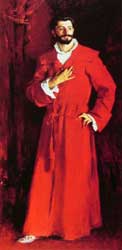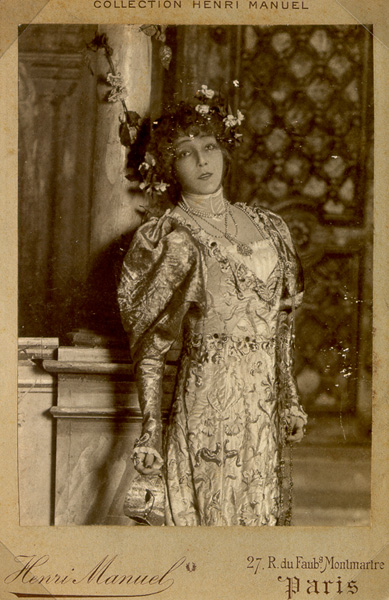Sarah
Bernhardt photo
Photograph
Place:
Paris, France
Photographer:
Henri
Manuel
jpg: University
of Pennsylvania Library
Sarah Bernhardt
(1844-1923), French
actress who became more than just world renown -- but a phonomina that
was extraordinary and sublime. Her beautiful voice, the grace of her
movement, and her fiery personality made Sarah one of the most famous
actresses
of her day -- arguably the most famous actresses of the entire 19th
century.
She had a pale face with frizzy red hair and processed a voice that was
so strong and beautiful -- of bell-like clarity with exquisite diction
-- that she set the standard for the finest French speech and was
acclaimed
everywhere as "the Divine Sarah". Her real name was Henriette-Rosine
Bernard.
In 1872 she joined
the company of
the French Theater where she rocketed to stardom from one triumph after
another. She appeared at the London Gaiety Theater in 1879, then in
1880-81
toured Denmark, Russia and America playing in "The
Lady of the Camellias" (known as "Camille" in the United
States)
a part that seemed to be almost made for her.
She was born the
daughter of a courtesan
(see Henri
Gervex's "Rolla"), educated at a convent before studying at
the Paris Conservatory from 1858 to 1862. Briefly, she appeared in
burlesque
quite unsuccessfully before finding her home in the French
Theater.
She became so famous and revered - a goddess of goddesses -- a true
superstar,
and held court with the other artists and people like Count
Robert de Montesquiou. Reportedly, one of her lovers was Dr. Samuel
Jean Pozzi.

Dr.
Samuel Jean Pozzi at Home
1881
After playing in
all the chief countries
in Europe, North and South America, as well as Australia, she returned
to London in 1892 where she asked Oscar Wilde to write her a play. The
result was Salome but while in rehearsal the Lord Chamberlain
(who
acted in the capacity of the chief public sensor) banned the play from
being shown.
She returned to
Paris in 1893 and
managed the Renaissance Theater for six years. Then in early of 1899
"the
Divine Sarah" left the Renaissance for the larger
Théâtre
des National and made a bold move by taking the
lead
in a French production of Hamlet [1].
It was clearly a success. She repeated the impersonation of men in 1900
as the fate-ridden son of Napoleon I, in Rostand's L'Aiglon. It too was
so successful she took it to London the following year. She eventually
opened her own Sarah Bernhardt Theater which she managed until her
death.
During World War I she performed for the troops near the front lines
and
would ultimately be awarded the Legion
of Honor.
.
Notes
1)
Men had taken the
roles of women
in theater for centuries -- as far back as Shakespeare and beyond to
the Greeks.
However,
it was exceptionally rare for a woman to have taken the lead role of a
man -- and a lead role in Shakespeare's most challenging play at
that.
For "the Divine Sarah" to have done it and done it successfully showed
her position and power in the theater and the reverence by which she
was
held.
But to say all that
doesn't quite convey the magnitude of this lady. She was so SO loved, and SO profoundly
revered that to be even remotely associated with her reaped rewards.
When Jules
Bastien-Lepage painted her the painting won him the cross of the Legion
of Honour; and when Antonio de la Gandara painted her it won him
the Silver Medal at the 1900 Worlds Fair.
“Sarah Bernhardt” –
the name spoke volumes well beyond her death. People were continually
(and sometimes even today) evoking her name to proclaim the next rising
actress superstar but rarely . . . rarely has
it ever been equaled -- not in the sense of how much she completely
overshadowed every one of her contemporaries including men.

|




